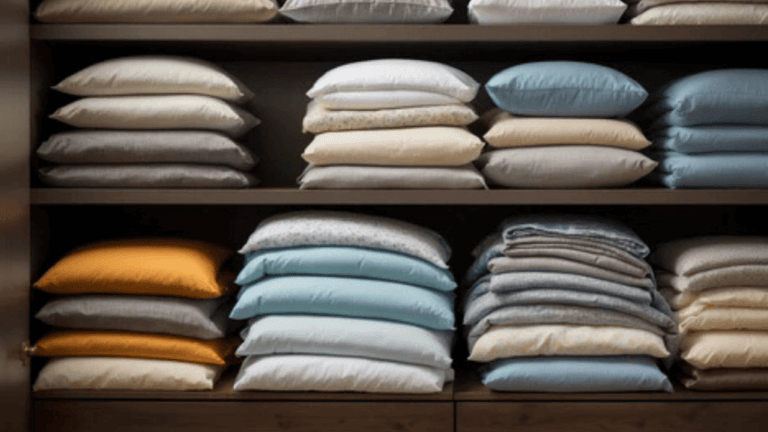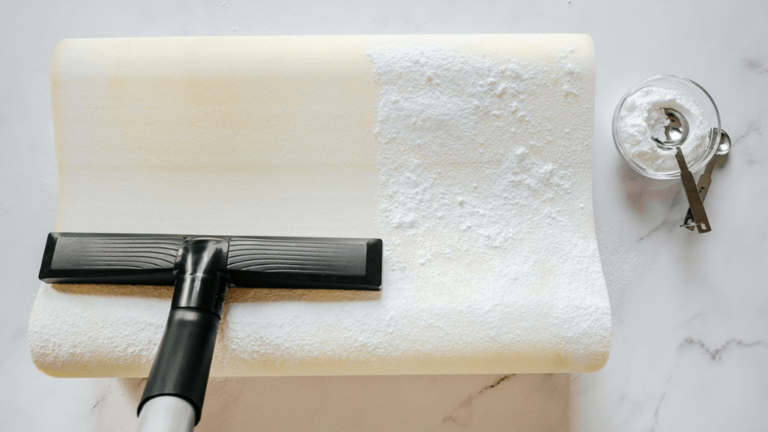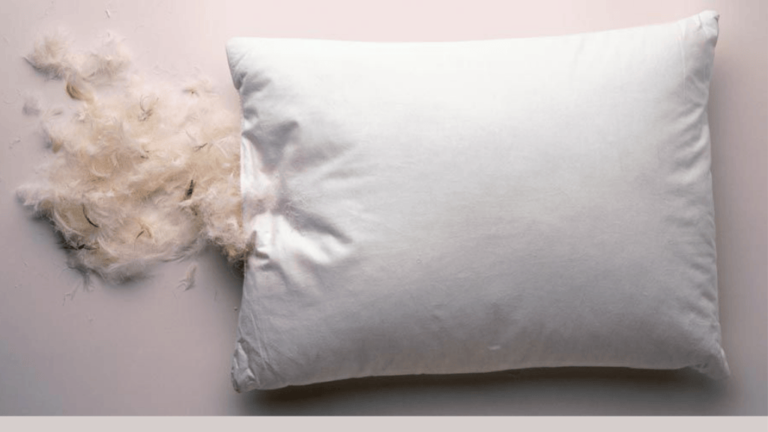Keeping your pillow clean is key to sleeping well and staying healthy. This guide focuses on My Pillow and provides detailed cleaning tips. By following these instructions closely, you can make your pillow last longer and stay fresh.
How to Wash My Pillow Safely, use less detergent than normal. Half the usual amount is best, which is about 3/4 of an ounce (22 mL). Wash it every four months to ensure it stays clean. A front-loading machine works well since it keeps the pillow underwater. Don’t add fabric softeners because they can harm the pillow. Also, fluff the pillow by hand before bed to keep its shape and support.
Key Takeaways
- Use 3/4 fluid ounce (22 mL) of detergent to wash MyPillow.
- Wash MyPillow every four months for optimal cleanliness.
- Avoid using fabric softeners during the wash cycle.
- Utilize a high heat dryer setting to dry MyPillow thoroughly.
- Hand fluff your MyPillow nightly to maintain foam distribution.
Introduction to Pillow Washing
It’s key to keep your pillows clean. This is important for their shape and your health. Our pillow maintenance guide tells you the best cleaning methods for different pillows. Clean pillows mean less dust mites, allergens, and body oils.
Importance of Keeping Pillows Clean
Hygiene is a must with pillows. If you use a bed pillow every night, wash it at least three times a year. If you sweat a lot or get sick, wash it even more. Change pillowcases weekly. This cuts down on dust mites and allergens for better health.
Common Pillow Types and Cleaning Needs
Pillow types need different care:
- Memory Foam and Solid Latex Foam Pillows: They can’t go in the machine. You must wash them by hand.
- Feather and Down Pillows: These can be machine-washed but follow special directions to keep them comfy.
- Decorative Pillows: If used rarely, they don’t need as much cleaning.
Washing your pillows regularly keeps them nice, especially if you sleep on them daily. Check out our pillow maintenance guide. It’s full of tips to clean your pillows well while keeping them soft and comfy.
Pre-Wash Preparations
Before you start washing your pillows, know a few key tips. Check the care labels first to make sure they can go in the washer. Some pillows, like memory foam or latex, need special care and might not be washable in a machine.
It’s important to treat stains before washing your pillows. Dab a damp cloth in soapy water to lightly clean any spots. This small step can reduce the times you need to wash the whole pillow, making it last longer.
Adding pillows to your usual laundry can keep them clean. Brands like MyPillow suggest washing the cover monthly and the case weekly. When you do a full wash, do at least two pillows together to even out the washer’s load.
Using the right detergent amount is also key. MyPillow recommends only 3/4 of an ounce (22 mL), which is less than usual. Don’t use fabric softener because it can change how your pillow feels and works.
Look out for signs that your pillows need a wash, like stains, smells, or they’re not as fluffy. Keeping them clean stops these problems and makes your pillows stay comfy and fresh.
| Pillow Type | Washing Frequency | Special Notes |
|---|---|---|
| MyPillow | Every 4 months | Do not use fabric softeners |
| Memory Foam | Every 2-3 months | Hand wash only |
| Feather/Down | Every 6 months | Check for tears or quills before washing |
| Polyester | Every 3-6 months | Wash with mild detergent |
How to Wash My Pillow in a Washing Machine
Keeping your pillow clean helps you sleep better and stay healthy. Here is a how-to guide for washing MyPillow products in a machine.
Selecting the Right Washing Machine Setting
Choosing the right machine setting is key. Use a front-loading machine for a gentle wash. This avoids damage to the pillow. Select a regular or gentle cycle with cold or warm water.
Using the Correct Detergent and Additives
Choosing the right detergent is crucial for your MyPillow’s life. Use half the usual amount, around 3⁄4 fluid ounce (22 mL). Don’t use softeners or dryer sheets. An extra rinse cycle is good to remove all detergent.
Balancing the Load
Balance your load to prevent damage. If you have a top-loader, wash two pillows together. This keeps the spin cycle steady, washing your pillows better.
| Parameter | Recommendation |
|---|---|
| Washing Frequency | Every 4 months |
| Detergent Amount | Half the standard amount (3⁄4 fluid ounce or 22 mL) |
| Machine Type | Front-loading recommended |
| Water Temperature | Cold or warm |
| Extra Rinse Cycle | Recommended |
| Fabric Softeners | Avoid |
These steps will keep your MyPillow fresh and clean. By following them, your pillow stays comfy and beneficial for your health.
Drying Your Pillow Properly
Drying your MyPillow the right way is key to keeping it comfy and fresh. If it gets wet, drying at a high heat is best. It stops mildew from growing and keeps your pillow in top shape.
If you’re looking for the best way to clean pillow, listen up. Let’s look at what the makers suggest:
- Use High-Heat Dryer Setting: Dry your pillow thoroughly on a high-heat setting. This is crucial to avoid dampness.
- No Fabric Softeners: Stay away from fabric softeners. They can harm your pillow’s filling.
- Fluffing Post-Dry: Don’t forget to fluff up your pillow after it dries. It keeps it nice and evenly filled.
Stick to these steps for drying your MyPillow just right. Doing so will make it last longer. Plus, you’ll sleep well knowing your pillow is clean and cozy.
Hand-Washing Techniques for Delicate Pillows
It’s crucial to hand-wash delicate pillows such as memory foam or latex. These types can get damaged in a washing machine. A gentle hand-wash helps keep them in good shape.
Preparing Your Hand-Washing Solution
To start, make a mild detergent mix. Use lukewarm water and a bit of gentle laundry detergent. Mix the solution well to clean your pillows effectively but gently.
Steps for Hand-Washing Memory Foam and Other Sensitive Pillows
- Submerge the pillow: Dip the memory foam or latex pillow in the soapy water. Make sure it’s completely soaked.
- Clean with care: Softly squeeze the pillow with your hands. This helps the soap go through. Be careful not to scrub hard, to avoid damage.
- Rinse thoroughly: Rinse the pillow with cold water. Keep rinsing until there’s no more soap left, following expert washing advice.
- Excess water removal: Gently squeeze to get rid of extra water. Don’t twist or wring it. This might ruin its shape.
- Air drying: Dry the pillow in a place with good air flow. Let it dry completely to avoid mold. Remember, memory foam pillows dry slowly, so be patient.
By following these steps, you can keep delicate pillows clean and long-lasting. Regular hand-washing and air-drying are important. They help preserve the quality of these special pillows without sacrificing their comfort and support.
Special Care Instructions for Different Pillow Types
Keeping your bedding clean is crucial for a comfortable sleep. Different pillows need special cleaning to last longer. We will look at how to care for feather, down, and wool pillows. We’ll also discuss easy-to-wash pillow options.
Feather and Down Pillow Cleaning Techniques
Feather and down pillows are gentle, but you can wash them if you’re careful. Use mild detergent and cold water when washing at home. This avoids hurting the feathers. Set your machine on a gentle, extra rinse cycle. This ensures all detergent is gone.
Tumble dry your pillows with tennis balls on low heat. This fluffs them up. It also stops clumping. By following these steps, you can wash your pillow safely.
Cleaning Wool Pillows Safely
Wool pillows need careful cleaning. Start by shaking them to remove dirt. For wool, use a wool detergent and hand wash in lukewarm water. Don’t wring or twist the pillow.
Rinse well and air dry it. Turn it often while drying. By doing this, the wool stays fluffy and doesn’t mat.
Machine-Washable Pillow Alternatives
If you prefer easy-to-clean options, try machine-washable pillows. Brands like MyPillow can handle lots of washes. Use about 3⁄4 fluid ounce (22 mL) of detergent per wash. Set your machine on gentle and dry them with high heat.
This is great for people with allergies. They should wash MyPillow every two months. Here’s how to care for different pillows:
| Pillow Type | Washing Frequency | Detergent Type | Drying Method |
|---|---|---|---|
| Feather and Down | Every 4-6 months | Mild Detergent | Tumble Dry on Low Heat |
| Wool | Every 6 months | Wool-Specific Detergent | Air Dry |
| MyPillow | Every 4 months (2 months for allergies) | 3⁄4 fluid ounce of Mild Detergent | High Heat in Dryer |
Each type of pillow needs its own cleaning method. Learning to clean your pillow well can make your sleep better. It’s all about meeting your personal sleep needs.
Using Pillow Protectors and Cases to Extend Pillow Life
Keeping your pillows clean and well-kept is key to making them last longer. One great way to do this is by using pillow protectors and cases. They help keep your pillows in good shape and clean. This part will tell you about the best materials for pillowcases. Plus, it’ll advise you on how to wash them right. It all follows the pillow maintenance guide.
Best Materials for Pillowcases and Covers
It’s crucial to pick the best materials for your pillowcases for comfort and hygiene. Many agree that a thick, coarser cotton bottom pillowcase works well with a finer top one. It makes your pillows last longer and gives you a comfy sleep. Sarah Natow from Buffy, a bedding company, likes 100% cotton for its softness and breathability. Using this combo extends your pillow’s lifespan, meaning you buy pillows less often.
How Often to Wash Pillowcases and Covers
Washing your pillowcases and covers regularly is important for keeping your pillows in good shape. Pillow protectors should be washed every other sheet wash, or at least once a month. It’s smart to have more pillowcases than you need and change them often. This keeps your pillows clean from hair products and makes them last longer.
Sarah Natow gives tips for washing pillow protectors. She says to let them sunbathe or use dryer balls for fluff. Even though protectors might make your pillows sound crunchy, using a softer, second layer can help. It makes the pillow more comfy. Following these care instructions for washing pillow cases and protectors helps keep your pillows cozy and durable.
How Often Should You Wash Your Pillow
Keeping your pillow clean is key for a healthy sleep spot. It’s important to wash it often to get rid of dust mites, oils, and allergens. This keeps your pillow in great condition for sleeping. Now, let’s go over how to clean your pillows right and how often you should do it.
The American Sleep Association says to wash your pillowcases every two weeks. Wash the pillows themselves every six months. Doing this removes dust mites and allergens, which might cause asthma and other problems. A 2018 study showed pillows can hold dust, fungi, sweat, drool, and natural oils. So, cleaning them regularly is a must.
- Natural filled pillows: Put them in the machine with the proper drying settings to keep them clean and smelling good.
- Polyester/hollowfibre pillows: Put them on the wool setting in your machine, use less detergent, then dry them in a dryer.
- Foam pillows: Clean them by hand in warm soapy water once a year.
Some pillows, like those made of foam or hypoallergenic materials, don’t get dirty as fast. But they still need regular care. Washing two pillows together helps them keep their shape.
It’s also a good idea to air your pillows out once a month. Wash your sheets and pillowcases every 1 to 2 weeks. Comforters need a yearly wash but should also be aired out monthly.
| Pillow Type | Washing Frequency | Cleaning Method |
|---|---|---|
| Natural filled | Every 6 months | Machine-wash, proper drying |
| Polyester/hollowfibre | Every 6 months | Wool program, reduced detergent, tumble-dry |
| Foam | Once a year | Sponge cleaning in warm soapy water |
By doing the right things to keep your pillows clean, you make your sleep space healthier. Asking and learning how to clean your pillow is worth it. Regular care improves sleep and health a lot.
Tips for Maintaining Pillow Freshness Between Washes
Keeping your pillows fresh is key for a healthy sleeping place. One big part of this is to fluff your pillows often. It spreads the stuffing and keeps the pillow comfy.
Also, make sure your pillows stay dry. Moisture causes mold, so using a pillow protector is smart. It shields against sweat and spills. Putting your pillows in the sun sometimes also helps. The UV rays combat bacteria and freshen them up.
Washing tips for pillows recommend dealing with stains right away. Use a mild detergent and water for this. Let them dry fully before putting them back.
Storing your pillows well makes a big difference. Pick breathable bags for storage to keep the pillows dust-free. Never use plastic bags. They can make the pillows damp, which is not good.
Following these simple steps will help you wash your pillows less often. It’ll keep your pillows in top condition for a long time. This supports good hygiene in your sleeping space.
Conclusion
Cleaning your pillows well is key to a good night’s sleep and lessening allergens. Washing them every three to six months helps get rid of dust and sweat. This practice is supported by experts as it makes your sleep area cleaner.
Knowing how to clean each type of pillow is important. Down and synthetic ones can be machine-washed. It’s best to use a gentle cycle and warm water. Don’t forget to add clean, dry tennis balls in the dryer to keep them fluffy.
Memory foam pillows, however, need gentle care. They should be hand-washed with mild soap and then air-dried. This keeps them supportive for longer.
It’s also wise to replace pillows every one to two years, especially if you have allergies. This prevents bacteria from building up. Some companies, like Puffy, provide lifetime warranties. They believe in the quality and lasting comfort of their pillows.
Regular care, like using pillow protectors, can greatly extend your pillows’ life. Airing them out is also beneficial. Following these guidelines ensures your pillows stay supportive and clean. This, in turn, improves how well you sleep.













